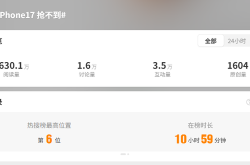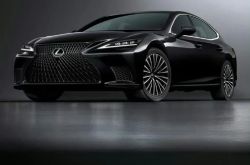The Boom of the 'Introvert Economy': Revolutionizing Seven Key Consumption Scenarios
![]() 09/30 2025
09/30 2025
![]() 598
598
Author | Cheng Yu
Disclaimer | The featured image is sourced from the internet. This article is an original work by Jingzhe Research Institute. For reprinting, please send a message to request permission.
*This article is a collaborative effort between Jingzhe Research Institute and 21st Century Business Herald · Nanfang Finance.

Since the MBTI personality test gained popularity online, introverts have often been stereotyped as socially anxious individuals. In the public eye, introverts are seen as preferring solitude and avoiding excessive interaction with others. This psychological preference has started to subtly influence changes in the consumer market.
Thus, in today's world, which increasingly values personalization and boundaries, certain business models that require minimal social interaction and precisely cater to the psychological needs of introverts are expanding from daily dining to lifestyle services. The resulting array of unmanned business formats is propelling the 'introvert economy'—which seeks quiet, autonomous, and low-interference consumption experiences—onto a new wave in the consumer market.
Unmanned Restaurants / Solo Dining: A Sanctuary for Introverts
In the past, dining alone was often negatively labeled as 'lonely' or 'pathetic,' but it has gradually evolved into a preferred consumption scenario for introverts. Especially, unmanned restaurants and solo dining models not only satisfy introverts' need for independent space but also represent one of the most iconic consumption scenarios of the 'introvert economy.' According to ResearchInChina, China's solo dining economy is projected to exceed RMB 1.8 trillion by 2025, with a compound annual growth rate of 15.3%.
Jingzhe Research Institute also noted in 'Young People Propel Seven New Tracks in the 'Solitary Living Economy'' that the demand for 'solo dining' has given rise to restaurants tailored for single diners. Notable examples include Japan's 'Ichiran Ramen,' Guangzhou's 'Yixin Yimian,' and Beijing's '23 Seats Noodle Bar.'
These restaurants share a common feature: they ensure timely responses to customer needs through independent compartments and call buttons, while avoiding the 'awkwardness' caused by frequent interactions with servers. Notably, this design not only caters to introverts but also attracts ordinary consumers seeking moments of solitude amid their busy lives.
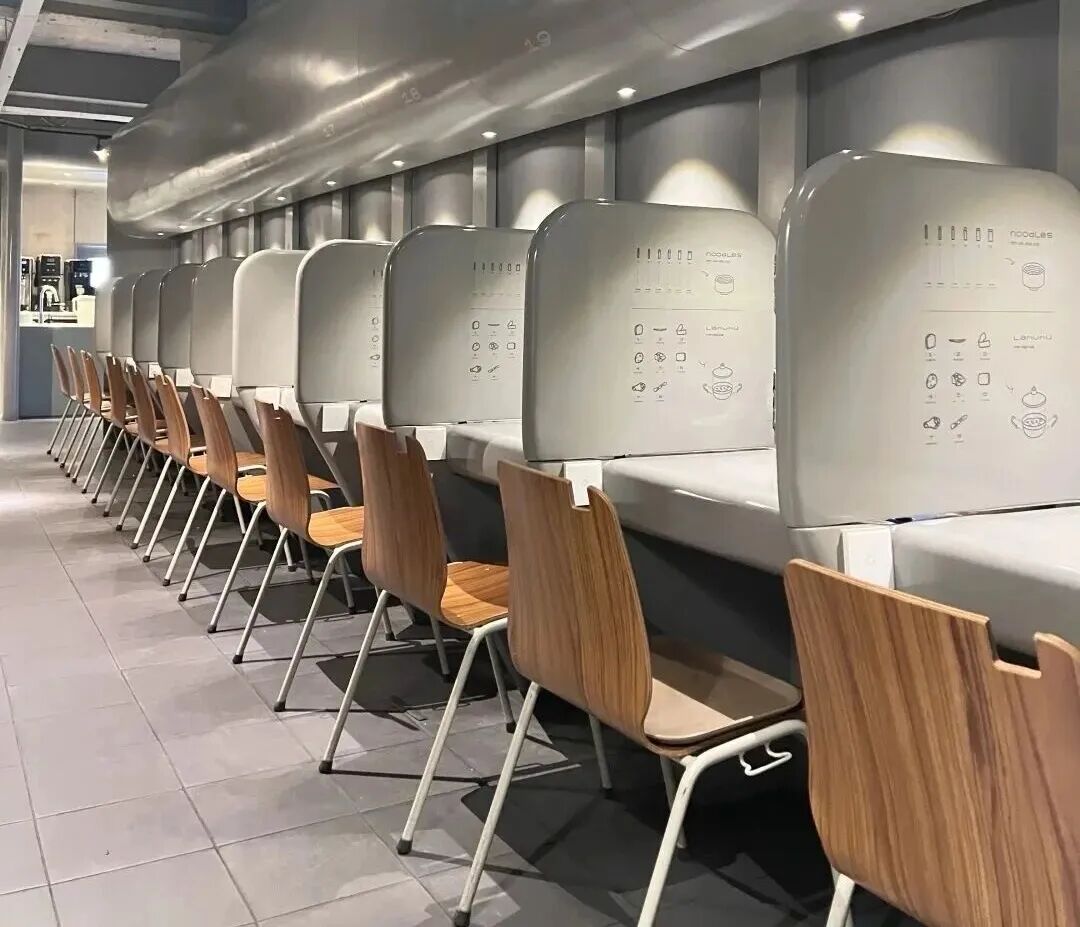
*Image source: Dianping account of 23 Seats Noodle Bar
Currently, China's 'solo dining' model is undergoing deep innovation toward localization and diversification, comprehensively covering dining needs across various scenarios. In terms of food categories, innovative strategies such as miniaturization, standardization, ritualization, and customization have led to the emergence of new product forms suitable for hot pot, fast food, Japanese cuisine, Chinese formal dining, and other fields.
Beyond traditional 'solo dining' models that balance service and independent dining needs, unmanned restaurants have emerged as highly innovative complements due to their strong alignment with single-person consumption demands. Unlike traditional restaurants or 'solo dining' venues with independent compartments, unmanned restaurants reconstruct dining service processes. They operate on a 'three-no' model (no ordering/serving staff, no chefs, no cashier counters or cashiers), using robots and intelligent interaction systems to completely eliminate social pressure from manual services, perfectly aligning with the need for 'efficiency, autonomy, and no disturbance' during solo dining.
The unmanned restaurants and solo dining options under the 'introvert economy' represent not only a technology-driven efficiency revolution but also an evolution in consumer culture. While they may not entirely replace traditional dining, they undoubtedly offer the industry an alternative value proposition—respecting individual psychological needs and spiritual spaces while pursuing scale and profit.
Unmanned Hotels: Intelligent Experience, 'Lie Down' in 30 Seconds
When thinking of hotel stays, most people envision the standard smile of front desk staff, the proficient check-in process, and the friendly 'Hello, do you have a reservation?' However, the hotel industry is quietly undergoing a dehumanized transformation.
For introverts, traditional hotel check-in processes that require front desk interactions, housekeeping communication, and even chance encounters with strangers in elevators or corridors can create psychological burdens. Unmanned hotels use technology to eliminate these social touchpoints as much as possible, creating a truly 'undisturbed accommodation experience.'
From pre-selecting rooms via mobile apps and online payments to facial recognition check-in and automatic smart door locks, to controlling all in-room devices via voice or mobile phone, the entire process requires no substantive interaction with anyone. The heightened sense of autonomy is precisely the emotional value that contemporary young consumers increasingly value.
In user experience design, unmanned hotels demonstrate meticulous consideration for 'solitude needs.' For example, they enhance soundproofing to avoid neighbor noise, equip rooms with higher-quality personal entertainment systems for leisure during solitude, and even offer personalized services, including smart-adjusted lighting, temperature, and bedding comfort.

*Image source: WeChat service account of Hangzhou FlyZoo Hotel
Amid the rising 'introvert economy,' such accommodation formats, centered on intelligent technology and minimizing interpersonal interaction, precisely cater to introverted consumers' desire for private space and low social pressure, becoming a highly promising innovation model in the hotel industry.
According to the '2024-2029 China Hotel Industry Market Supply and Demand and Key Enterprise Investment Assessment Research Analysis Report,' the global smart hotel market size is expanding yearly and is expected to grow from approximately $5 billion in 2020 to $15 billion by 2027, with a compound annual growth rate of around 15%.
The rise of unmanned hotels represents not only a transformation in the hotel industry but also a microcosm of the broader evolution in the service sector. It proves that replacing repetitive manual services with technology in appropriate areas is not only feasible but even superior. As technology advances and consumer attitudes evolve further, unmanned hotels may transition from a marginal innovation experiment to a mainstream choice in the hospitality industry, redefining people's imagination of accommodation experiences.
Unmanned Supermarkets: Curing 'Queue PTSD'
While introverts draw energy from solitude, they still need to venture out to purchase daily necessities. The unintentional social interactions in traditional supermarkets often serve as hidden 'consumption burdens'—a cashier's gentle 'Would you like to know about today's promotions?' can unconsciously slow their pace and make them want to avoid it, disrupting their focused shopping rhythm with unnecessary conversation.
In contrast, office workers rushing during morning peaks face 'efficiency dilemmas' in traditional retail scenarios. While hot coffee and bread from convenience stores are breakfast essentials, queues can instantly diminish their convenience. Every second spent waiting at the cashier feels like racing against the clock.
Whether it's the 'social pressure' faced by introverts or the 'time anxiety' of office workers, both stem from shortcomings in traditional retail models regarding user experience. The emergence of unmanned supermarkets precisely minimizes these disturbances and inconveniences.

*Image source: Dianping account of Xingbianli
Unmanned supermarkets are essentially a form of digital transformation in the retail industry. Their highly automated operations require embedding RFID tags (radio-frequency identification tags) in products or tracking them through image recognition technology. Shelves are equipped with weight sensors to monitor inventory in real-time, while multi-angle cameras mounted on ceilings accurately identify consumer shopping behaviors through computer vision algorithms. Relying on digital technologies, unmanned supermarkets can extend operating hours to 24/7, breaking free from traditional retail time constraints.
Notably, unmanned supermarkets also demonstrate significant potential in supply chain optimization. By monitoring inventory in real-time, systems can automatically generate restocking orders, predict sales trends, and even dynamically adjust product displays. Some advanced unmanned supermarkets have begun introducing robots for shelf restocking and cleaning, further reducing labor demands.
However, the development of unmanned supermarkets remains immature. Accurately identifying similar products, handling situations where multiple customers shop simultaneously, and preventing accidental damage to goods or tag detachment all require continuously optimized algorithms.
At the consumer level, the lack of human service reduces pressure but also limits help channels when issues arise. More profoundly, the widespread adoption of unmanned supermarkets may create a digital divide, excluding groups unfamiliar with smartphone operations.
Overall, unmanned supermarkets may not entirely replace traditional retail, but they undoubtedly provide a crucial development direction for the industry—respecting each consumer's personal boundaries and choices while pursuing efficiency.
Unmanned Self-Study Rooms: Learning Spaces Tailored for Introverts
In today's fast-paced and fiercely competitive society, students face academic pressure from exams and certifications, while office workers need continuous learning to advance in their careers. Consequently, the demand for quiet, comfortable, and convenient dedicated learning spaces has become increasingly urgent.
Against this backdrop, 'unmanned self-study rooms,' designed almost precisely around introverts' core needs for low social disturbance and high independence, have emerged as a new business model that precisely matches user pain points. Within the 'space rental, flexible services' commercial framework, they demonstrate potential aligned with contemporary consumption trends and quickly secure a place in urban life.
The rapid establishment of unmanned self-study rooms stems from their precise targeting of current learning space gaps. From a user perspective, urban living spaces are generally cramped, making it difficult to guarantee a quiet study or work environment at home. Public libraries have limited seating and fixed opening hours, failing to meet flexible timing needs. While cafes are open, their noisy environments, scarce power outlets, and psychological burdens of occupying seats for extended periods pose challenges.
The convergence of these needs makes the emergence of unmanned self-study rooms inevitable. To better align with diverse user consumption habits and strengthen customer loyalty, unmanned self-study rooms employ refined pricing strategies. According to Jingzhe Research Institute's observations, they typically adopt hourly rental models with tiered pricing for different durations (e.g., hourly, half-day, full-day) while offering membership packages like daily passes, monthly cards, and seasonal subscriptions to lock in long-term consumption. Some self-study rooms further differentiate pricing by seat type (standard seats, immersion desks, sunlit desks, lounges) to cater to varying needs from basic studying to deep focus.

*Group-buying platform's unmanned self-study room
As demand continues to surge, the market size for self-study rooms is expanding rapidly. According to a report by Jiangsu Economic Daily on April 18, 2025, Qichacha data shows that 85,300 self-study room-related enterprises exist in China. Additionally, educational hardware brands like Zuoyebang and Songshu AI are entering this market, attempting to lock in student populations with innovative 'AI self-study room' products and models.
However, the unmanned self-study room industry faces undeniable challenges: current profit paths remain relatively singular, with most brands relying on space rentals, resulting in weak risk resistance. Meanwhile, intense homogeneous competition further compresses profit margins.
Notably, learning has become a 'lifelong need' for people beyond work and daily life. As the industry continues to explore these deep-seated needs and upgrades operational models, this niche sector may well nurture 'industry champions' dominating the market in the future.
Unmanned Pet Washing Stores: Stress-Free and Cost-Effective Pet Grooming
For pet owners, washing their pets often means 'chaos at home, exorbitant costs at stores, half-day commutes for pick-up/drop-off, and concerns about cross-infection.' If their pet happens to be an 'introverted pet'—timid by nature and wary of strangers—the situation becomes even more complex. Owners must repeatedly explain their pet's unique habits to staff, from adjusting hair-drying intensity to controlling nail-trimming force, requiring constant communication and leaving them on edge throughout the process.
According to the '2024 China Pet Consumption Trends Report,' 78% of pet owners cite grooming as their biggest pain point, with cost-effectiveness and convenience as core demands. Thus, unmanned pet washing spaces perfectly align with office workers' fragmented time and cost-effectiveness needs while minimizing social energy consumption.
Scanning a code to enter, selecting a pool to start washing, drying, and leaving confidently—the entire process requires no verbal communication. Owners can focus entirely on their pets, washing at their own pace without feeling rushed or engaging in unexpected chitchat.
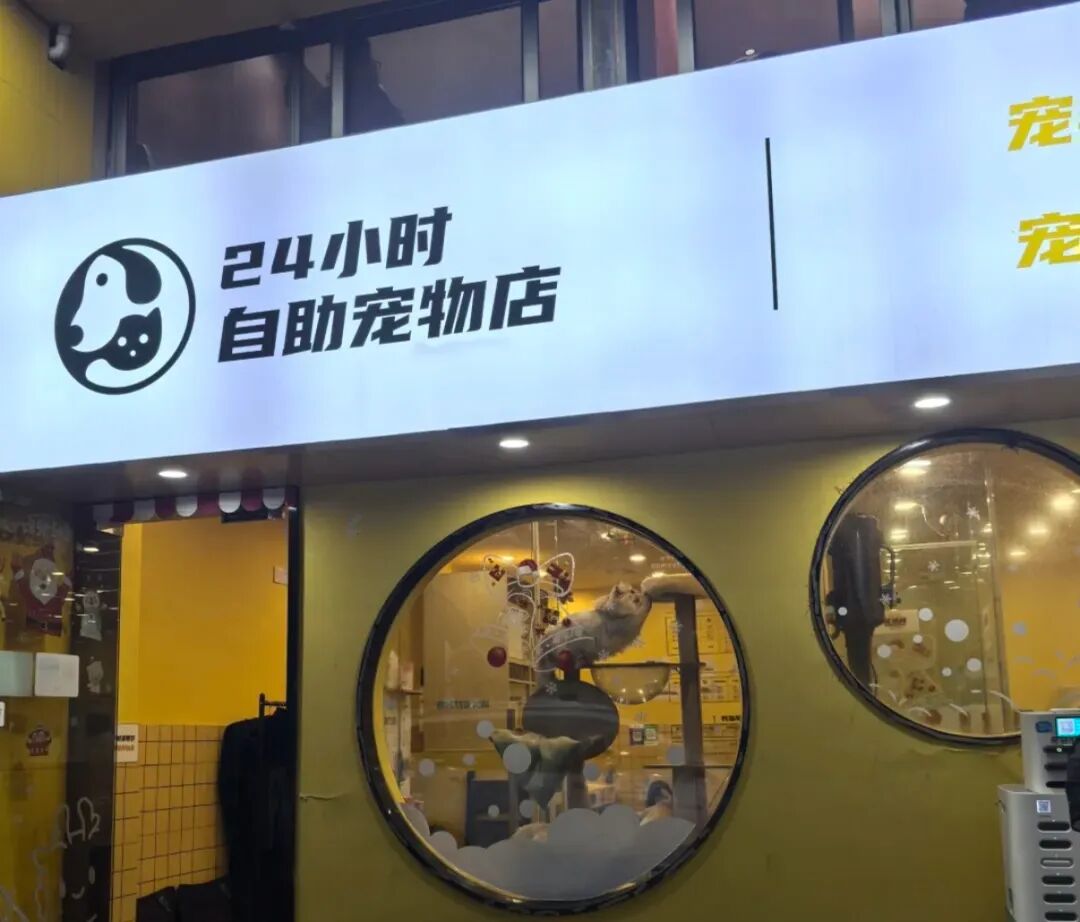
*Image source: Dianping account of Yuanqi Dayuchang 24h Self-Service Pet Store
Notably, unmanned pet - washing stores cater not only to introverts but also to aggressive or timid pets that lack socialization training and are sensitive to unfamiliar surroundings. Additionally, they appeal to ordinary pet owners who want to save time and avoid waiting in lines at pet stores.
Moreover, unmanned pet - washing services are not synonymous with "cheap" or "subpar services." Instead, with the support of intelligent technology, they offer more refined services and pricing. Through smart billing systems, fees are accurately calculated based on factors such as pet weight, grooming duration, and the selected service modes (e.g., basic cleaning, hair - care SPA, de - miting treatment). This enables consumers to pay only for the services they truly require.
Against the backdrop of a booming pet economy and shared lifestyles deeply integrated into urban daily life, unmanned pet - washing stores, which combine convenience, technology, cost - effectiveness, and safety, undoubtedly expand the possibilities for pet services.
Self - Service Car Washes: Cost - Effective and Stress - Relieving
No membership cards, no queues, the ability to wash at any time, affordable prices, and the stress - relieving experience of DIY car washing—for introverted car owners, 24 - hour self - service car washes are gradually becoming a necessity for the masses due to their cost - effectiveness, convenience, unmanned service, and stress - relieving qualities.
Although traditional car wash shops have been around for a long time, factors like prices ranging from 30 to 100 yuan and the time cost of waiting in line can negatively impact car owners' consumption decisions. In contrast, self - service car washes have gained favor among more car owners because of their flexibility in terms of cost and time.
Currently, most self - service car wash services on the market use billing models based on time or water usage volume, with the average cost of washing a car ranging from 10 to 20 yuan. The significant differences in cost and efficiency have further widened the gap in consumer preferences between traditional car washes and self - service ones.
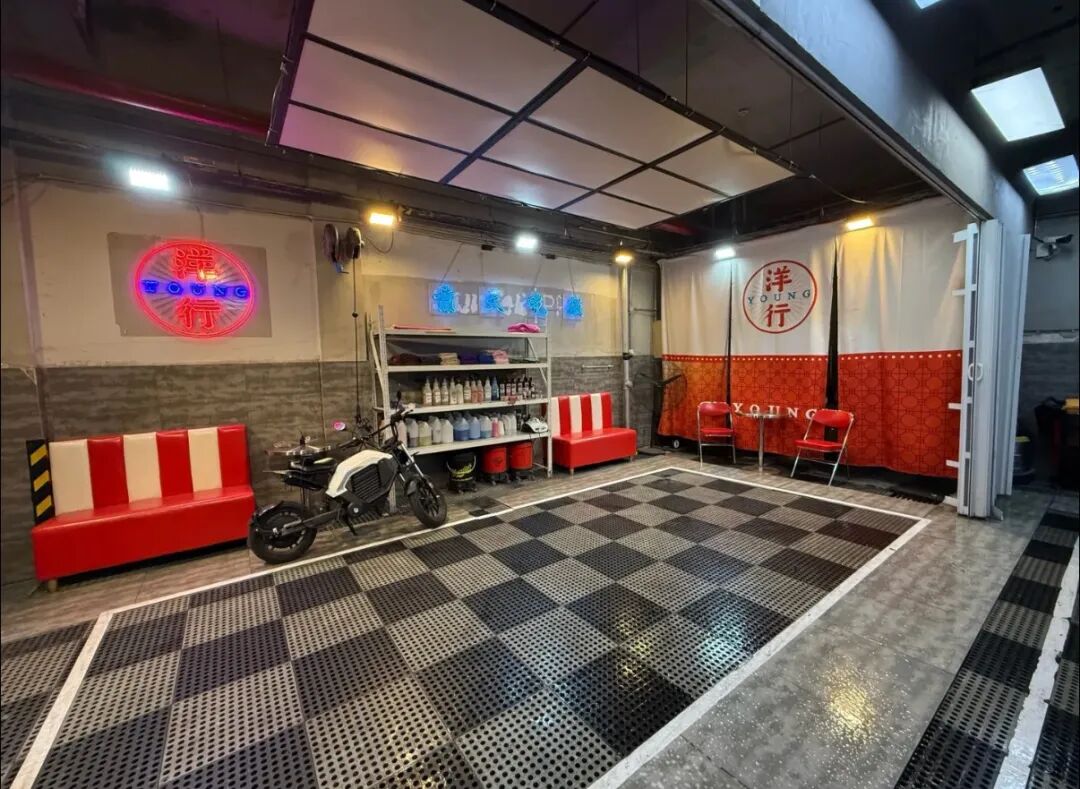
*Image source: Dianping account of Yanghang Shenye Self - Service Car Wash Studio
Meanwhile, the rapid increase in domestic car ownership has also provided development opportunities for the self - service car wash industry. According to statistics from the Ministry of Public Security, by the end of 2024, the total number of cars in China had reached 353 million, of which 31.4 million were new energy vehicles, accounting for 8.90% of the total car ownership.
Unlike traditional car wash shops, which rely on manual service capabilities, the core competitiveness of self - service car washes lies in equipment reliability, payment convenience, and network coverage. Among these, Internet of Things (IoT) technology and mobile payments form the key infrastructure, enabling users to complete operations such as locating nearby service points, checking queue status, making remote payments, and activating equipment through mobile apps or mini - programs in one go.
People desire convenience along with efficiency and relaxation amid solitude. It is foreseeable that as the population of introverted individuals (i - people) grows and young people's preference for experience - focused consumption continues to spread, service models like self - service car washes, which emphasize efficiency, privacy, and freedom, will continue to thrive.
Self - Service Clothing Stores: "Purely Self - Service, Very Thoughtful"
Over the past few decades, transformations in the clothing industry have almost always centered around three core aspects: price regulation, channel expansion, and inventory management. Whether it's optimizing supply chains to reduce prices, deploying multi - channel strategies to reach consumers online and offline, or using data to predict demand and reduce inventory backlogs, the ultimate goal of these measures has always been to boost sales performance. However, in the relentless pursuit of sales targets, the clothing industry has overlooked a crucial issue: providing consumers with a service experience that is just right and non - intrusive.
Many people have encountered similar shopping dilemmas: feeling uncomfortable when sales staff closely follow them every time they enter a clothing store; or feeling guilty when they want to try on multiple sizes of a garment to compare the fit, worrying about being judged by the salesperson if they ultimately decide not to make a purchase.

In response to the subpar experiences that may arise from "human factors" in shopping scenarios, a new type of self - service clothing store has quietly emerged in cities. Leveraging their affordable pricing, non - intrusive "i - people - friendly" model, and the freedom to "try on as you please," these stores are being discovered by more and more young people through social media platforms and have become a popular new choice for "treasure hunting."
Through searches, Jingzhe Research Institute found that user reviews of self - service clothing stores mostly revolve around aspects such as "affordable prices," "no disturbance," and "good shopping experience." Many also express a high repurchase rate, stating that they "visit once a month." This positive word - of - mouth dissemination allows self - service clothing stores to achieve steady customer growth without massive advertising investments.
From online reviews, it is evident that the core competitiveness of self - service clothing stores lies in filling the "experience gap" in traditional clothing consumption scenarios. The consumption needs of today's young generation have upgraded from "purchasing goods" to "enjoying the process." They are no longer willing to pay for unnecessary social costs or compromise on their consumption experience due to price concerns. Self - service clothing stores precisely meet the needs of young consumers for both price and shopping experience through their "affordable and non - intrusive" approach.
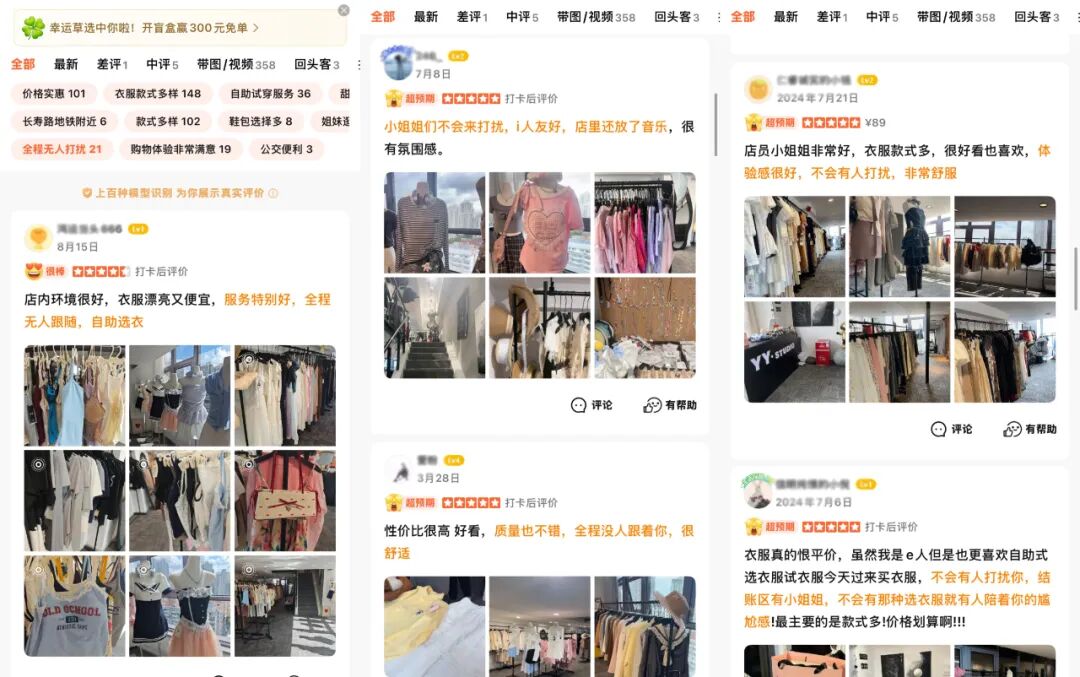
*User reviews of unmanned clothing stores
However, self - service clothing stores also face some challenges. Due to their unmanned or lightly staffed operational models, issues such as garments not being promptly returned to their original positions after being tried on can occur. Scattered clothing not only affects the store's cleanliness but also the shopping experience of new customers. Additionally, some stores have lapses in hygiene management, such as failing to promptly organize and disinfect tried - on garments.
Furthermore, the lightly staffed operational model also presents challenges in restocking and replacing goods. For example, delayed restocking of popular items can impact overall revenue, while outdated seasonal items not being updated in a timely manner can lead to inventory buildup, resulting in excess storage costs and reduced operational efficiency. In summary, finding a balance between "non - intrusiveness" and "providing service" is an ongoing exploration direction for self - service clothing stores in the future.
Nevertheless, it cannot be denied that for the entire clothing industry, the popularity of self - service clothing may be just the beginning. It serves as a mirror, reflecting the industry's past shortcomings in service experience and reminding all practitioners that while pursuing sales and efficiency, greater attention must be paid to consumers' emotional needs and shopping experiences. Only by truly understanding consumers' deep - seated pursuits of "personal boundaries," "cost - effectiveness," and "experience" can long - term and stable development be achieved.
Summary
The rise of the "i - people economy" does not negate traditional consumption models but rather opens a window for diverse needs. In such consumption scenarios, consumers do not have to engage in social interactions reluctantly to avoid embarrassment or compress their needs due to others' gazes. Everyone can enjoy consumption at their own pace.
This respect for "individual boundaries," whether reflected in the optimization of service processes or the innovative design of consumption spaces, always revolves around the commercial essence of "people - oriented" value creation and exchange. Only when every consumer feels respected and understood in their consumption can the consumption ecosystem unleash more enduring vitality.







